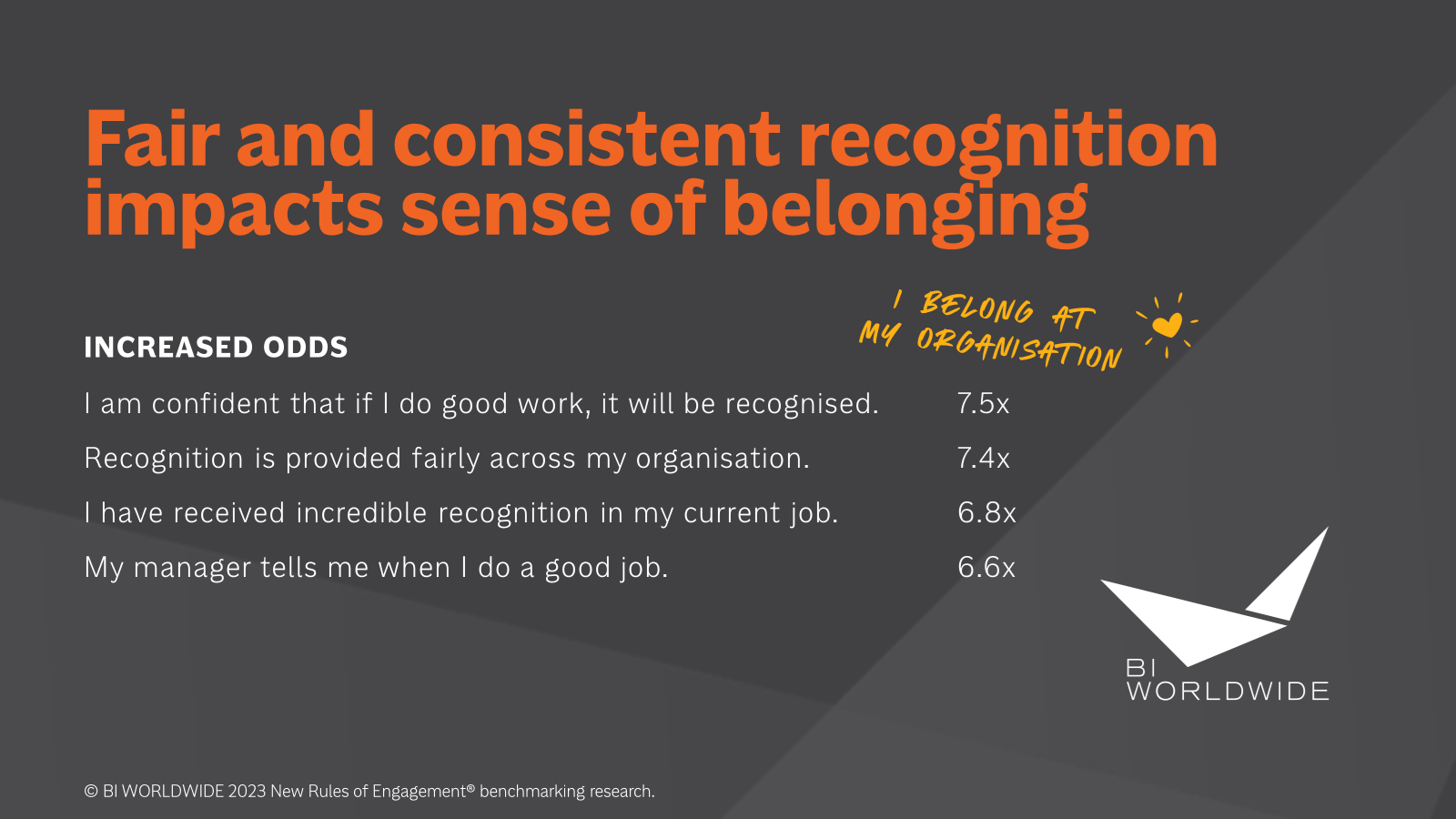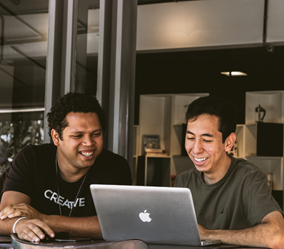Recognition strategies to drive inclusion and connection
In a new age for reward and recognition, how can HR leaders open up the opportunities that recognition strategies offer to enlighten and inspire?
Using our client experiences and insights from our 2023 global employee study, The New Rules of Engagement, read on or watch our talk below to learn how we’re witnessing the evolution of effective recognition strategies to deliver both insight and change that directly impacts employee inclusion, connection, and performance.
By Phil Williams, Head of Employee Programmes

Recognition strategies are evolving. For many of our clients, we’ve seen them develop beyond their original visions to now perform a central role in driving the performance, inclusion, and connection of their employees all over the world.
The fundamentals of recognition strategies remain unchanged. People value meaningful work and appreciate recognition for their contribution. Recognition programmes need to be globally and culturally nuanced, engaging, audience smart, web and mobile enabled, and include a breadth of aspirational rewards. We already know that employees that are part of a formal recognition programme like this are over 3 times more likely to say they have a great company culture.
But there are also clear shifts in what today’s workers value. Diversity, equity, and inclusion have rightfully become central to workplace culture. Those workplaces, and whether they’re location-based, hybrid or remote are heavily influencing employees’ engagement as well as their physical and mental health. Sustainability strategies are directly impacting customer choices, employee recruitment and retention and, in turn, these issues are impacting bottom line results of businesses.
Consequently, there are now changes in the questions that your employees are asking themselves; questions like…
- Do I feel like I belong in this organisation, and does it walk the talk of the values it champions?
- Do I feel connected to the organisation and feel safe here to be my most authentic self?
- Will my employer look out for me – for my physical and mental wellbeing?
- Is my employer having a positive influence on society and the wider world?
Watch the video here or read on below...
Do I feel like I belong? How is recognition supporting diversity, equity and inclusion?
We know that this has become an increasingly important measure of culture…
Does it suit me? Do I see people like me progressing here? Do I feel included?
Research and experience tell us that the businesses that get this right really reap the benefits…
In our research, those that do feel included said they are 6 times more likely to work as hard as they can and 17 times more likely to say that working brings out their best ideas.
That’s backed up by our 2023 engagement survey which found that those employees who do feel included are 15 times more likely to find work inspiring than those who do not, and nearly 80% of those who feel included would recommend their organisations as great places to work.

On the flipside, it also revealed some ominous pitfalls for those that don’t get it right…
Those who feel there’s inequity in their organisation were 4 times more likely to wish they were working somewhere else and over a third of them are planning to leave their organisation in the next 12 months. They were also 7 times more likely to feel harassed at work and 4 times more likely to report that harassment.
So clearly, there are both human and business costs and risks associated with inequity in an organisation and huge upsides to making employees feel included.
Where does your recognition strategy fit in?
The results from our latest research are clear. Those who say they feel like they belong in their organisation are very often also the beneficiaries of great recognition.

If they’re confident good work is recognised, believe that recognition is given fairly, have a manager that tells them when they do a good job or have received incredible recognition themselves, they’re about 7 times more likely to say those three invaluable words - “I belong here!”
This is one of the reasons why BI WORLDWIDE and others in our industry are using AI and algorithms to build tools like recognition, equity, and inclusion advisors within our platforms, not just to enhance the quality of the recognition experience for each recipient but to ensure that nobody’s unconscious, confirmation or conformity bias gets in the way of making other employees feel included.
Do I feel connected? How are recognition strategies building employees’ sense of connection?
One of the greatest challenges HR leaders are facing is the re-imagining of a workplace culture now that the workplace is no longer one dimensional - how do we make and maintain a great company culture with an increasingly remote workforce?
Again, our 2023 New Rules of Engagement research painted a very interesting picture of employee’s connection to their manager, their organisation and the organisations culture depending on whether they were working completely remote or onsite or hybrid.

It’s interesting to see that whilst 100% remote might be slightly ahead of 100% onsite right now, that the levels of agreement with these statements are broadly similar, whereas hybrid working, in blue, is showing a clear advantage.
Compared to those working hybrid, we see that others were less connected to their company cultures, less energised and inspired, and less confident leaders were doing the right thing for them.
Recognition is a key component of connection
If we apply the recognition lens to this overarching question of connection to culture, the results do look quite different.

When we posed the second statement in the list “I feel connected to my company culture”, there’s a clear difference for those who have been recently recognised and those who haven’t.
Those who work only remotely and only onsite, who have received recognition in that setting feel almost as connected to that company culture as those who work hybrid.
Another key component appears to be wellbeing, or the answer to the question - will my employer look out for me – do they care about my health?
If we look at the example of “burnout”, our research tells us that the actual number of hours worked by someone experiencing the symptoms of burnout are just one hour more per week than someone who doesn’t feel the same way.
When we dig deeper, we see that the real issue lies with a lack of connection, especially connection between their work and the values and goals of their organisation…they simply believe their job, or their contribution, doesn’t make a difference at that moment.
Whereas employees who reported having a healthy workplace culture are also at least twice as likely to feel their manager understands them, their ideas are taken seriously, and they’re confident the good work they do will be recognised.
So, it turns out, too much work doesn’t cause burnout, but too little meaning and too little recognition can…and companies who recognise individuals that live out their values have employees who are nearly 11 times more likely to say their company actively supports their overall wellbeing.
Does it drive my performance? How are recognition strategies impacting employee performance?
Historically, there was a very clear preference in the companies we spoke with to keep employee recognition for behaviours and employee rewards for results very separate, often in completely discreet programmes, driven by different parts of the Sales and HR organisations. It was often felt that their objectives were competing, and their audiences were different and discreet.
However, in more recent years, two things have happened.
Firstly, on a practical level, employee recognition programmes have increasingly succeeded in creating a single global reward and recognition infrastructure, where all the complex components of technology, tax, payroll, data privacy, and reward delivery have been considered and taken care of.
Secondly, the sales team and its culture increasingly don’t exist as an island within organisations, they are far more integrated into a one company vision where the same purpose, values, and behaviours apply to all.
And so, the initial evolution of the recognition strategy to reach more employees by incorporating peer to peer recognition, manager recognition, nomination programmes, service anniversaries, and life events under a single framework now continues to evolve by focusing on two other key areas.
- Consideration of strategic imperatives like sustainability, wellbeing, and innovation
- Adding recognition for results alongside recognition for behaviours
Many of our current clients are now embracing these two opportunities with a broad range of promotions, rewards and incentives being added to their core recognition programme.
However, it’s not a “free for all”. For the clients we work with, there’s strong governance in place to ensure that all activity is within the guiding principles of the programme established during the original design process, the breadth of reward and recognition opportunities for the employee is increasingly diverse, and the number of employees engaging continues to grow.
- One of our global banking clients launched a recognition initiative across 57 countries to spotlight behaviours in support of nine specific ESG objectives. Over 200,000 personal recognitions were made in 2 months to support their sustainability strategy and, importantly, from those recognitions we’ve been able to harvest hundreds of personal success stories from all over the world that can be shared more widely as a clear picture of “what great behaviours looks like” when they support sustainability.
- It also demonstrated to the Global Head of Sustainability that the level of knowledge and understanding that was already within the workforce meant their ESG communication strategy could by pushed forward by nearly 18 months.
- Another client embracing this approach now has over 60 live tactical initiatives on their recognition platform, all targeted at discreet audiences, supporting initiatives as diverse as innovation schemes, recruitment referrals, wellbeing awards, hackathons, and risk assessment awards.
- A global pharmaceutical client is utilising their recognition programme to drive energy into their oncology research and innovation strategy with a new approach to team rewards and compensation for breakthrough work and outcomes.
There’s no doubt that there’s a clear direction of travel across most of our clients with recognition and rewards for behaviours and results now sitting alongside each other, under a single strategy or framework, usually allowing the employee to combine and accumulate their rewards across all programmes for bigger ticket merchandise, mastery, travel, or experience awards.
The response to a workplace that continues to change is the rapid evolution of our client’s recognition strategies. We all know the table stakes for a successful employee recognition programme and although everybody may not be there yet, it's a well-trodden path with a mass of experience and research to drive a great design and implementation.
The new challenges are:
- Placing your recognition strategies at the centre of other people programmes, such as recruitment, onboarding, and retention
- Maximising its impact on strategic imperatives, such as sustainability, wellbeing, and innovation
- Building a bridge to your real business objectives and organisational targets
By addressing these three challenges you’ll find that your recognition strategy is uniquely positioned to drive your employees’ sense of inclusion, improve their connection to your culture, and focus their performance on your organisation’s strategic goals.
Unlocking inspiration
Find out the tactics to connect and inspire your organisation
BI WORLDWIDE can help you discover the right ways to engage your whole workforce.
Click here to discover more about our Employee Engagement Solutions and see how we can work together to develop a customised engagement strategy that will help your business achieve its goals.













